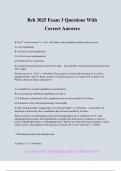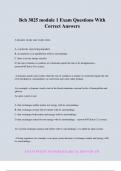Bch 3023 - Study guides, Class notes & Summaries
Looking for the best study guides, study notes and summaries about Bch 3023? On this page you'll find 14 study documents about Bch 3023.
Page 2 out of 14 results
Sort by

-
Bch 3025 Exam 3 Questions With Correct Answers
- Exam (elaborations) • 61 pages • 2024
-
- $13.49
- + learn more
Bch 3025 Exam 3 Questions With Correct Answers If the G'° of the reaction A -> B is -40 kJ/mol, under standard conditions the reaction: A) is at equilibrium. B) will never reach equilibrium. C) will not occur spontaneously. D) will proceed at a rapid rate. E) will proceed spontaneously from left to right. - answerE) will proceed spontaneously from left to right. For the reaction A - B,G'° = -60 kJ/mol. The reaction is started with 10 mmol of A; no B is initially present. After 2...

-
BCH 3025 Exam 1 Questions With Correct Answers
- Exam (elaborations) • 10 pages • 2024
- Available in package deal
-
- $12.49
- + learn more
BCH 3025 Exam 1 Questions With Correct Answers In a bacterial cell, the DNA is in the: - answernucleoid A major change occurring in the evolution of eukaryotes from prokaryotes was the development of: - answerthe nucleus In eukaryotes, the nucleus is enclosed by a double membrane called the: - answernuclear envelope The dimensions of living cells are limited, on the lower end by the minimum number of biomolecules necessary for function, and on the upper end by the rate of diffusion of so...

-
Bch 3025 module 1 Exam Questions With Correct Answers
- Exam (elaborations) • 7 pages • 2024
- Available in package deal
-
- $12.49
- + learn more
Bch 3025 module 1 Exam Questions With Correct Answers A dynamic steady state results when A. a molecule stops being degraded. B. an organism is at equilibrium with its surroundings. C. there is no net energy transfer. D. the rate of intake or synthesis of a molecule equals the rate of its disappearance - answerChoice D is correct. A dynamic steady state results when the rate of synthesis or intake of a molecule equals the rate of its breakdown, consumption, or conversion into some other...
Bch 3025 Exam Package Deal.

Do you wonder why so many students wear nice clothes, have money to spare and enjoy tons of free time? Well, they sell on Stuvia! Imagine your study notes being downloaded a dozen times for $15 each. Every. Single. Day. Discover all about earning on Stuvia



